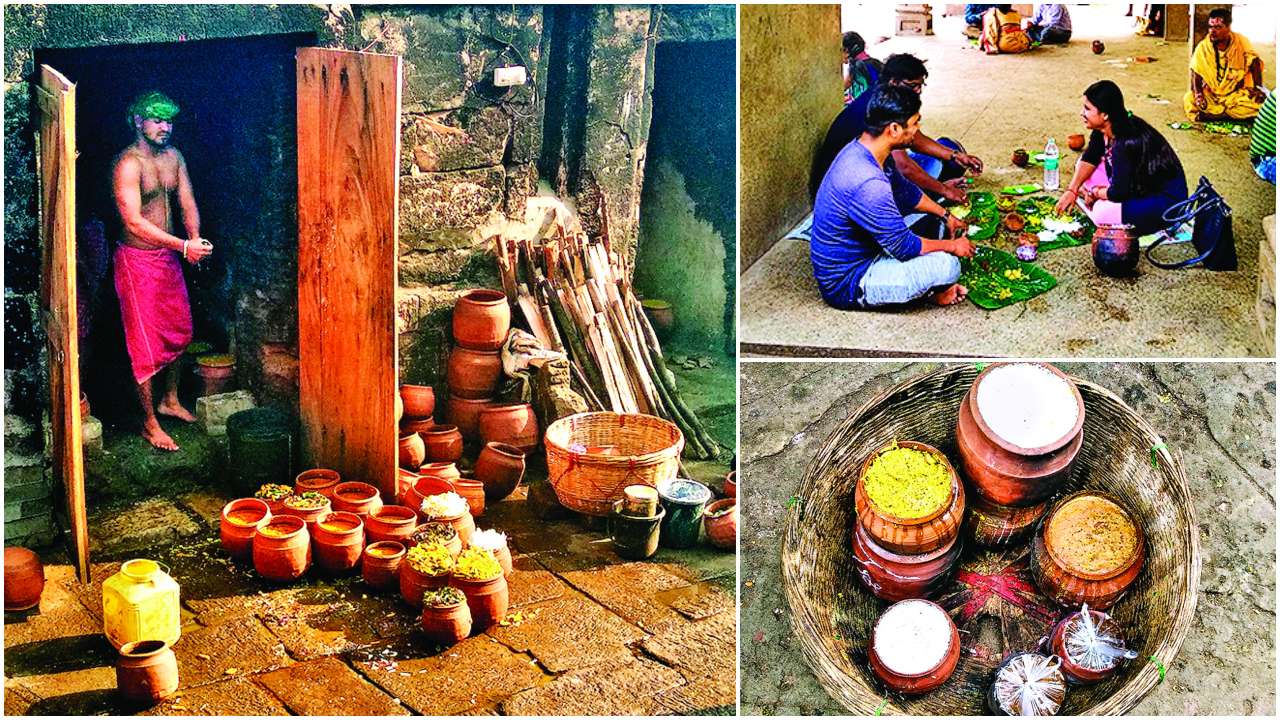
One fine sunny, humid afternoon in December, I purchased my 'plate' – a big, lush green plantain leaf – with a side of spice – spoonful of salt and three chilies – for Rs 5. I was at the prasad serving area in Ananta Basudeva Temple, situated on the banks of the Bindusagar lake in Bhubaneswar, Orissa. Apart from it being the only Vaishnavite temple in the Shiva temple cluster here, and the only one known to have been built by a woman – Queen Chandrika from the Eastern Ganga Dynasty, devotees throng to the 13th-century AD Kalinga-style sandstone temple to consume its daily prasad (also called abhada) or food that is blessed after it is offered to Lord Krishna in a puja that ends sharp noon.
The suaras (temple chefs) – all men, bare-chested and clad in red dhoti, and not too bothered about food etiquette, or ambience – run the space. As I walked to the food counters barefoot – the norm is to leave footwear outside – I felt stray grains of rice, dal, lentils that had escaped the kuduhas (clay pots) or the mouths of devotees and tourists, mash under my feet. After the mini conundrum of which counter should I patronise as all served identical dishes, I cringed slightly at the state of the counters – cubicles blackened by years of food spill and the kuduhas caked with thick runlets of gravies.
Either because I was alone or my appearance suggested I was close to penury, a suara suggested I sat in his counter, behind his clay pots. My other choice was the eating hall in front of the counters, where groups of eaters huddled cross-legged, wolfing down the contents of their plantain leaf plates. Not wanting to feel orphaned, I sat on the blackened floor with my niggling doubts of hygiene, table manners and my clothes getting dirty. I wondered how yet, given the condition of the space, this temple daily receives 10-15,000 orders. And how many in and around Bhubaneswar, this prasad is their first choice for any festive meal.
But my fears vamooshed as the chef started to pile large portions of a variety of food on my leaf. First, hot sadha arna (plain rice) glazed with ghee, then dalma (lentils with chunks of eggplant, sweet potato and bodhi or dried root vegetable and beans), followed by two vegetable gravies – besara (pieces of yam, snake gourd, pumpkin, banana, radish, grated coconut, cumin, bay leaf, dried red chili in mustard paste) and potala rasa (diced bottle gourd in coconut chutney) and a cooling agent called nadiya pachadi (grated coconut and curd chutney).
This meal belongs to the chhappan bhog or 56-item Mahaprasad offered to Lord Krishna, who, epics say, eats eight times a day. It is said that Krishna lifted the Govardhan mountain for a week to shelter the people of Vrindavan from torrential rains sent by the angry Lord Indra. In gratitude, the people fed him 56 dishes (8 times x 7 days) to compensate the meals he skipped.
While the entire Mahaprasad is daily prepared at one of Orissa's famous shrines, the Jagannath Temple in Puri, Ananta Basudeva, just prepares 10-12 dishes. Only seasonal ingredients indigenous to India are used. "No tomato, cabbage, capsicum, onion, ginger, garlic, and instead of potatoes, it is yam or sweet potato," Cuttack-based chef Rachit Kirteeman, later told me over the phone. "Also, lots of pumpkin, leafy vegetables like radish and saag (amaranthus)." Sort of like the bowl meal fad – where all the preparations involve mixing up and steaming all the lentils, vegetables, salt, turmeric, coriander, cumin, ghee and water in one kuduha. True enough, the meal, devoid of spices and sautéing or frying in oil, felt wholesome and 10 minutes into eating it I was full. "It is gluten-free, and only steamed on wood fire in pure ghee – which burns fat faster than oil or butter," Kirteeman has grown up eating the temple food and still continues to, though he snubs at the deplorable condition and addition of crunchy deep-fried toppings to the besara.
About 300 families from a Brahmin sect, with mostly 'Mohapatra' as surname, serve the temple. Generations of suaras come from these families with their kitchens stationed on the temple's left compound. Few others cut vegetables and make new kuduhas every day as only virgin earthen pots are used. "So no jhoota (leftover food) is accidentally mixed with the new preparation."
The men begin to cook at 4.30am, after a ritual dip in the river, followed by a meal that comprises of all their favourite dishes to kill any remanants of gluttony. Including meat or fish. "The idea is that if content, one won't feel like eating the temple food [on the sly] while preparing it," says Kirteeman. If that happens, the sanctity of the dish is 'contaminated', and would've to be discarded and prepared from scratch.
You can either order a plantain meal or the whole kuduha that comes in four sizes, and prices. Large orders are packed off in the cane baskets, also at a fee.